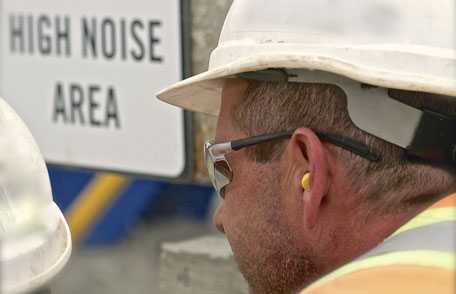Protect Your Hearing, Promote Hearing Health
 October is National Protect Your Hearing Month. Find out if noise at your workplace is affecting your hearing and learn how to prevent noise-induced hearing loss. Monitor noise levels and protect your hearing.
October is National Protect Your Hearing Month. Find out if noise at your workplace is affecting your hearing and learn how to prevent noise-induced hearing loss. Monitor noise levels and protect your hearing.
Noise-induced hearing loss is one of the most common work-related illnesses in the United States. Each year, an estimated 22 million U.S. workers encounter noise exposures loud enough to be potentially hazardous. In addition to hearing loss and other hearing disorders, prolonged exposure to noise can increase cardiovascular health risks, affect workers’ quality of life, and carry a high economic price to society.
Am I at Risk?
Occupational hearing loss occurs as a result of workers’ exposure to loud noise. Noise levels over 85 decibels can be hazardous to hearing. If you have to raise your voice to speak to someone an arm’s length away, the noise levels may be loud enough to damage your hearing. You could also use a smartphone sound level meter app to get a rough estimate of noise levels. To learn more about sound measurement apps, read the NIOSH Science Blog. If any of these quick screening methods indicate that noise levels may be hazardous, companies should conduct a complete noise survey.

October is National Protect Your Hearing Month. Monitor the noise and learn more about smartphone sound level meter apps.
Your level of risk is influenced by several factors:
- Noise level – as noise level increases, the risk also increases
- Duration of exposure – the longer the noise lasts, the more hazardous it becomes
- Impulsiveness – noises that have very abrupt starts and stops (such as hammering, gunfire, or fireworks) are more dangerous than constant noise of the same overall level
- Intermittency – periods of relative quiet between exposures allow the ear to “rest” and reduce the risk
Ototoxic chemicals can also affect hearing. Workplace chemicals that pose a threat to hearing include:
- Organic solvents – e.g., toluene, styrene, xylene, ethylbenzene, trichloroethylene
- Heavy metals – e.g., mercury, lead, trimethyltin
- Asphyxiants – e.g., carbon monoxide, hydrogen cyanide
- Endocrine disrupters – e.g., Aroclor 1254, Acrylonitrile
All workers are not equally vulnerable to occupational hearing loss. Certain biological factors such as gender, age, race/ethnicity, genetics, and health issues can influence a worker’s susceptibility to the effects of noise.
The ear does not experience pain in the same way the rest of the body does. If your ears feel stuffy or full, your ears are telling you that you have potentially harmed them. Ringing or roaring in your ears indicate a serious noise exposure, which if continued could lead to permanent damage and hearing loss.

For more information about the NIOSH Hearing Loss Prevention program, follow us on Twitter @NIOSHNoise and check out our regular science blogs on hearing loss.
How Can I Protect Myself?
The National Institute for Occupational Safety and Health (NIOSH) recommends preventing hazardous noise exposure through controls for noise exposure and encourages employers to create Buy Quiet programs as a first step. Learn more about Buy Quiet by visiting our website.
Although removal or control of hazardous noise from the workplace is the best solution, use hearing protectors in situations where dangerous noise exposures have not yet been eliminated. NIOSH has developed several tools that provide valuable information about hearing protection devices:
- Hearing Protector Device Compendium is a comprehensive searchable database of hearing protection devices. This web tool was created to help workers and safety professionals select the most appropriate product for their unique environment. The tool identifies hearing protector devices by type, manufacturer, and noise exposure level.
- NIOSH HPD Well-Fit™ can quickly and inexpensively test the performance of hearing protection. This fit-testing technology is a significant advancement in efforts to preserve workers’ hearing. HPD Well-FitTM utilizes technology that is built into just about every computer sold today, requires only 4-7 minutes to measure HPD performance, and can be used with any earplug.
In order to minimize occupational risks and reduce work-related hearing loss, companies and organizations should implement Hearing Loss Prevention programs. Critical components to any Hearing Loss Prevention Program include:
- Noise exposure monitoring
- Engineering and administrative controls
- Audiometric evaluation
- Hearing protection devices
- Education and motivation
- Record keeping
- Program evaluation
More Information
More Information
- Noise and Hearing Loss Prevention
- NIOSH Hearing Loss Research Program
- Hearing Loss Prevention for Mining
- Hearing Loss Prevention Programs
- Hearing Conservation Tool Box
- Hearing Conservation Check List
- NIOSH Buy Quiet
- Controls for Noise Exposure
- Occupational Hearing Loss Surveillance
- CDC Healthy Youth – Noise Induced Hearing Loss
- CDC Hearing Loss in Children
Additional Resources
- Page last reviewed: October 7, 2015
- Page last updated: October 7, 2015
- Content source:
- National Institute for Occupational Safety and Health
- Page maintained by: Office of the Associate Director for Communication, Digital Media Branch, Division of Public Affairs




 ShareCompartir
ShareCompartir